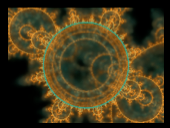Fractal Architect 4 Help Index
Triangle Editor Tutorial
Applies to:FA 4
Flame fractals’ shapes are determined by the its transforms, and those tranform’s geometric variations and matrix triangle settings. This window is the only place in Fractal Architect to access the transforms and their properties.
See: What makes a Flame Fractal?
Reference: Triangle Editor
Fractal Architect makes it easy to quickly change various parameter values and see the changes in the fractal image resulting from those changes. The current fractal state is shown by a floating thumbnail image.
The key interactive areas are:
Fast rerendering
To keep image rendering fast, its important to keep the thumbnail window small. It can be resized by dragging the bottom-right corner of the image. Thumbnail rendering time is shown on the Fractal Architect log window. Its good to keep the rendering time down to about 1/2 second or so.
Use Quicklook to see a bigger image
Click on the thumbnail image window and press the spacebar. You should see the Quicklook window pop up. Press the spacebar again to close it. Quicklook is available throughout the application.
Triangle Viewport Tutorial
Open this fractal:

Go to the Welcome Screen window. (One way is to use the menu: Window > Welcome to Fractal Architect. Or use the Command- ~ (Command+tilde) key combination to quickly cycle through the application’s windows.)
Click on the Gallery tab. Double click on the thumbnail image to open its Preview window. Right click with the mouse to open the preview window’s context menu and select: Open Triangle Editor….
Rotating the triangle
By default the first transform is selected. Let’s rotate the transform’s triangle. Using either mouse or trackpad, hover the cursor over the triangle. You should see a different cursor symbol depending on where the cursor is relative to the triangle. (See: Triangle Viewport for more on those cursors.)
Move the cursor over either the red or the blue line extending from the triangle. You should now see the rotation icon. Next, click and drag the cursor to cause the triangle to rotate.
Watch the fractal image and you should see a portion of the fractal rotate along with the triangle!
Scaling the triangle
Let’s scale the transform’s triangle.
Move the cursor over either the the triangle edge opposite the little black square. You should now see the scaling icon. Next, click and drag the cursor to cause the triangle to grow or shrink.
Watch the fractal image and you should see how the matrix scale factor affects the image.
Quick-Spin Tutorial
Changing transform variation weights with Quick-Spin This tutorial continues from the prior one. Scroll the Variation list until you see the diamond variation name. Click on the Quick-Spin button to the right of the Weight column.
Set the maximum value text field to the number 2. Drag the slider and watch the thumbnail image change.
Hit the undo button to undo your change. Set the Interpolation Points to 8. Click the Interpolate button.
Select any of the thumbnail images and press the spacebar. The Quicklook window should open showing the appearance for that corresponding Diamond variation weight. Press the spacebar again to close it.
Select yet another thumbnail image and press the Return key. That will assign its numeric value to the variation weight.
If you like, use the menu: File -> Save As to save your changed fractal to another file name.
Tips and TroubleShooting
My fractal image disappeared and all I see is the background color!
This is called a diverging fractal, where the point iteration process causes the points to leave the area seen through the fractal image. One common culprit is a transform matrix expansion with a large scale factor value.
Numbers of transforms and number of variations per transform
Experience has shown that keeping the number of transforms to 3 or 4 and the number of variations to 1 or 2 is a good approach. Each variation type imparts its own characteristic shape signature to them. Too many variations make it harder predict how the fractal will evolve.
Soloing transforms
The solo button is a quick temporary tool for visualizing how a single transform is affecting the fractal. The solo setting is NOT written to the output file, thus is a temporary aid for visualization. A permanent way to make one transform dominate is to set the opacity settings for other transforms to near zero.